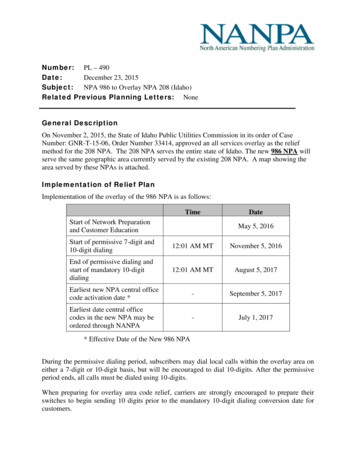
Transcription
Toric VarietiesDavid CoxJohn LittleHal SchenckD EPARTMENT01002OFM ATHEMATICS , A MHERST C OLLEGE , A MHERST, MAE-mail address: dac@cs.amherst.eduD EPARTMENT OF M ATHEMATICS AND C OMPUTER S CIENCE , C OLLEGETHE H OLY C ROSS , W ORCESTER , MA 01610OFE-mail address: little@mathcs.holycross.eduD EPARTMENT OF M ATHEMATICS , U NIVERSITYC HAMPAIGN , U RBANA , IL 61801E-mail address: schenck@math.uiuc.eduOF I LLINOIS ATU RBANA -
c 2010, David Cox, John Little and Hal Schenck
PrefaceThe study of toric varieties is a wonderful part of algebraic geometry that has deepconnections with polyhedral geometry. Our book is an introduction to this richsubject that assumes only a modest knowledge of algebraic geometry. There areelegant theorems, unexpected applications, and, as noted by Fulton [58], “toricvarieties have provided a remarkably fertile testing ground for general theories.”The Current Version. The January 2010 version consists of seven chapters: Chapter 1: Affine Toric Varieties Chapter 2: Projective Toric Varieties Chapter 3: Normal Toric Varieties Chapter 4: Divisors on Toric Varieties Chapter 5: Homogeneous Coordinates Chapter 6: Line Bundles on Toric Varieties Chapter 7: Projective Toric MorphismsThese are the chapters included in the version you downloaded. The book also hasa list of notation, a bibliography, and an index, all of which will appear in morepolished form in the published version of the book. Two versions are availableon-line. We recommend using postscript version since it has superior quality.Changes to the January 2009 Version. The new version fixes some typographicalerrors and includes a few new examples, new exercises and some rewritten proofs.The Rest of the Book. Five chapters are in various stages of completion: Chapter 8: The Canonical Divisor of a Toric Variety Chapter 9: Sheaf Cohomology of Toric Varietiesiii
ivPreface Chapter 10: Toric Surfaces Chapter 11: Resolutions and Singularities Chapter 12: The Topology of Toric VarietiesWhen the book is completed in August 2010, there will be three final chapters: Chapter 13: The Riemann-Roch Theorem Chapter 14: Geometric Invariant Theory Chapter 15: The Toric Minimal Model ProgramPrerequisites. The text assumes the material covered in basic graduate courses inalgebra, topology, and complex analysis. In addition, we assume that the readerhas had some previous experience with algebraic geometry, at the level of any ofthe following texts: Ideals, Varieties and Algorithms by Cox, Little and O’Shea [35] Introduction to Algebraic Geometry by Hassett [79] Elementary Algebraic Geometry by Hulek [91] Undergraduate Algebraic Geometry by Reid [146] Computational Algebraic Geometry by Schenck [153] An Invitation to Algebraic Geometry by Smith, Kahanpää, Kekäläinen andTraves [158]Readers who have studied more sophisticated texts such as Harris [76], Hartshorne[77] or Shafarevich [152] certainly have the background needed to read our book.We should also mention that Chapter 9 uses some basic facts from algebraictopology. The books by Hatcher [80] and Munkres [128] are useful references.Background Sections. Since we do not assume a complete knowledge of algebraicgeometry, Chapters 1–9 each begin with a background section that introduces thedefinitions and theorems from algebraic geometry that are needed to understand thechapter. The remaining chapters do not have background sections. For some of thechapters, no further background is necessary, while for others, the material moresophisticated and the requisite background will be provided by careful referencesto the literature.The Structure of the Text. We number theorems, propositions and equations basedon the chapter and the section. Thus §3.2 refers to section 2 of Chapter 3, andTheorem 3.2.6 and equation (3.2.6) appear in this section. The end (or absence) ofa proof is indicated by , and the end of an example is indicated by .For the Instructor. We do not yet have a clear idea of how many chapters canbe covered in a given course. This will depend on both the length of the courseand the level of the students. One reason for posting this preliminary version on
Prefacevthe internet is our hope that you will teach from the book and give us feedbackabout what worked, what didn’t, how much you covered, and how much algebraicgeometry your students knew at the beginning of the course. Also let us know ifthe book works for students who know very little algebraic geometry. We lookforward to hearing from you!For the Student. The book assumes that you will be an active reader. This meansin particular that you should do tons of exercises—this is the best way to learnabout toric varieties. For students with a more modest background in algebraicgeometry, reading the book requires a commitment to learn both toric varieties andalgebraic geometry. It will be a lot of work, but it’s worth the effort. This is a greatsubject.What’s Missing. Right now, we do not discuss the history of toric varieties, nordo we give detailed notes about how results in the text relate to the literature. Wewould be interesting in hearing from readers about whether these items should beincluded.Please Give Us Feedback. We urge all readers to let us know about: Typographical and mathematical errors. Unclear proofs. Omitted references. Topics not in the book that should be covered. Places where we do not give proper credit.As we said above, we look forward to hearing from you!January 2010David CoxJohn LittleHal Schenck
ContentsPrefaceiiiNotationxiPart I: Basic Theory of Toric Varieties1Chapter 1.3Affine Toric Varieties§1.0.Background: Affine Varieties§1.1.Introduction to Affine Toric Varieties10§1.2.Cones and Affine Toric Varieties23§1.3.Properties of Affine Toric Varieties35Appendix: Tensor Products of Coordinate RingsChapter 2.Projective Toric Varieties34849§2.0.Background: Projective Varieties49§2.1.Lattice Points and Projective Toric Varieties54§2.2.Lattice Points and Polytopes62§2.3.Polytopes and Projective Toric Varieties74§2.4.Properties of Projective Toric Varieties85Chapter 3.Normal Toric Varieties93§3.0.Background: Abstract Varieties93§3.1.Fans and Normal Toric Varieties105§3.2.The Orbit-Cone Correspondence114§3.3.Toric Morphisms125§3.4.Complete and Proper139vii
ContentsviiiAppendix: Nonnormal Toric VarietiesChapter 4.Divisors on Toric Varieties149153§4.0.Background: Valuations, Divisors and Sheaves153§4.1.Weil Divisors on Toric Varieties168§4.2.Cartier Divisors on Toric Varieties174§4.3.The Sheaf of a Torus-Invariant Divisor187Chapter 5.Homogeneous Coordinates193§5.0.Background: Quotients in Algebraic Geometry193§5.1.Quotient Constructions of Toric Varieties203§5.2.The Total Coordinate Ring217§5.3.Sheaves on Toric Varieties224§5.4.Homogenization and Polytopes230Chapter 6.Line Bundles on Toric Varieties243§6.0.Background: Sheaves and Line Bundles243§6.1.Ample Divisors on Complete Toric Varieties260§6.2.The Nef and Mori Cones279§6.3.The Simplicial Case290Appendix: Quasicoherent Sheaves on Toric VarietiesChapter 7.Projective Toric Morphisms301305§7.0.Background: Quasiprojective Varieties and Projective Morphisms305§7.1.Polyhedra and Toric Varieties309§7.2.Projective Morphisms and Toric Varieties318§7.3.Projective Bundles and Toric Varieties324Appendix: More on Projective MorphismsChapter 8.The Canonical Divisor of a Toric Variety334339§8.0.Background: Reflexive Sheaves and Differential Forms339§8.1.One-Forms on Toric Varieties350§8.2.Differential Forms on Toric Varieties357§8.3.Fano Toric Varieties371Chapter 9.Sheaf Cohomology of Toric Varieties379§9.0.Background: Cohomology379§9.1.Cohomology of Toric Divisors390§9.2.Vanishing Theorems I402
Contentsix§9.3.Vanishing Theorems II413§9.4.Applications to Lattice Polytopes422§9.5.Local Cohomology and the Total Coordinate Ring434Appendix: Introduction to Spectral Sequences447Topics in Toric Geometry379Chapter 10.453Toric Surfaces§10.1.Singularities of Toric Surfaces and Their Resolutions453§10.2.462§10.3.Continued Fractions and Toric SurfacesGröbner Fans and McKay Correspondences472§10.4.Smooth Toric Surfaces481§10.5.Riemann-Roch and Lattice Polygons489Chapter 11.Resolutions and Singularities499§11.1.Toric Resolution of Singularities499§11.2.Other Types of Resolutions510§11.3.Rees Algebras and Multiplier Ideals519§11.4.Toric Singularities530Chapter 12.The Topology of Toric Varieties545§12.1.Homotopy of Toric Varieties545§12.2.The Moment Map552§12.3.Singular Cohomology of Toric Varieties557§12.4.The Cohomology Ring569§12.5.Complements583Chapter 13.The Riemann-Roch Theorem595Chapter 14.Geometric Invariant Theory597Chapter 15.The Toric Minimal Model Program599Bibliography601Index609
NotationBasic NotionsZ, Q, R, CNim, kerlimintegers, rational numbers, real numbers, complex numberssemigroup of nonnegative integers {0, 1, 2, . . . }image and kerneldirect limitliminverse limit Rings and VarietiesC[x1 , . . . , xn ]C[[x1 , . . . , xn ]]C[x1 1 , . . . , xn 1 ]V(I)I(V )C[V ]C[V ]dC(V )Spec(R)Proj(S)VfR f , RS , RpR′polynomial ring in n variablesformal power series ring in n variablesring of Laurent polynomialsaffine or projective variety of an idealideal of an affine or projective varietycoordinate ring of an affine or projective varietygraded piece in degree d when V is projectivefield of rational functions when V is irreducibleaffine variety of coordinate ring Rprojective variety of graded ring Ssubset of an affine variety V where f 6 0localization of R at f, a multiplicative set S, a prime ideal pintegral closure of the integral domain Rxi
NotationxiiRbOV ,p , mV ,pTp (V )dimV , dim p VSX YR C SX S YVb Sing(X )completion of local ring Rlocal ring of a variety at a point and its maximal idealZariski tangent space of a variety at a pointdimension of a variety and dimension at a pointZariski closure of S in a varietyproduct of varietiestensor product of rings over Cfiber product of varietiesaffine cone of a projective varietydiagonal map X X Xsingular locus of a varietySemigroupsILZAZ′ANASSσ Sσ,NC[S]Hlattice ideal of lattice L Zslattice generated by APPelements si 1 ai mi ZA with si 1 ai 0affine semigroup generated by Aaffine semigroupaffine semigroup σ Msemigroup algebra of SHilbert basis of Sσ when σ is strongly convexCones and FansCone(S)σSpan(σ)dim σσ Relint(σ)Int(σ)σ τ σ, τ στ HmHm convex cone generated by Srational convex polyhedral cone in NRsubspace spanned by σdimension of σdual cone of σrelative interior of σinterior of σ when Span(σ) NRset of m MR with hm, σi 0τ is a face or proper face of σface of σ dual to τ σ, equal to σ τ hyperplane in NR defined by hm, i 0, m MR \ {0}half-space in NR defined by hm, i 0, m MR \ {0}
NotationΣΣ(r)uρΣmaxNσN(σ)M(σ)Star(σ)Σ (σ)ind(σ)xiiifan in NRr-dimensional cones of Σminimal generator of ρ N, ρ Σ(1)maximal cones of Σsublattice Z(σ N) Span(σ) Nquotient lattice N/Nσdual lattice of N(σ), equal to σ Mstar of σ, a fan in N(σ)star subdivision of Σ along σindex of a simplicial conePolyhedraConv(S)Pdim PHu,b Hu,bQ P, Q PP nA BkPC(P)σQΣPϕPconvex hull of Spolytope or polyhedrondimension of Phyperplane in MR defined by h , ui b, u NR \ {0}half-space in MR defined by h , ui b, u NR \ {0}Q is a face or proper face of Pdual or polar of a polytopestandard n-simplexMinkowski summultiple of a polytope or polyhedroncone over a polytope or polyhedroncone of a face Q Pnormal fan of a polytope or polyhedronsupport function of a polytope or polyhedronToric VarietiesM, χ mN, λuTNMR , MQNR , NQhm, uiYA , XAcharacter lattice of a torus and character of m Mlattice of one-parameter subgroups of a torus andone-parameter subgroup of u Ntorus N Z C HomZ (M, C ) associated to N and Mvector spaces M Z R, M Z Q built from Mvector spaces N Z R, N Z Q built from Npairing of m M or MR with u N or NRaffine and projective toric variety of A M
NotationxivUσ Uσ,NXΣ XΣ,NXPXDφ, φRγσO(σ)V (σ) O(σ)Dρ O(ρ)DFUPUΣaffine toric variety of a cone σ NRtoric variety of a fanprojective toric variety of a lattice polytope or polyhedrontoric variety of a basepoint free divisorlattice homomorphism of a toric morphism φ : XΣ1 XΣ2and its real extensiondistinguished point of Uσorbit of σ Σclosure of orbit of σ Σ, toric variety of Star(σ)torus-invariant prime divisor on XΣ of ρ Σ(1)torus-invariant prime divisor on XP of facet F Paffine toric variety of recession cone of a polyhedronaffine toric variety of a fan with convex supportSpecific VarietiesCn , P nP(q0 , . . . , qn )C (C )nCbd , CdBl0 (Cn )BlV (τ ) (XΣ )HrSa,baffine and projective n-dimensional spaceweighted projective spacemultiplicative group of nonzero complex numbers C \ {0}standard n-dimensional torusrational normal cone and curveblowup of Cn at the originblowup of XΣ along V (τ ), toric variety of Σ (τ )Hirzebruch surfacerational normal scrollDivisorsOX,DνDdiv( f )D ED 0Div0 (X )Div(X )DivTN (XΣ )CDiv(X )local ring of a variety at a prime divisordiscrete valuation of a prime divisor Dprincipal divisor of a rational functionlinear equivalence of divisorseffective divisorgroup of principal divisors on Xgroup of Weil divisors on Xgroup of torus-invariant Weil divisors on XΣgroup of Cartier divisors on X
NotationCDivTN (XΣ )Cl(X )Pic(X )Supp(D)D U{(Ui , fi )}{mσ }σ ΣPDΣDDPϕDSF(Σ, N)xvgroup of torus-invariant Cartier divisors on XΣdivisor class group of a normal variety XPicard group of a normal variety Xsupport of a divisorrestriction of a divisor to an open setlocal data of a Cartier divisor on XCartier data of a torus-invariant Cartier divisor on XΣpolyhedron of a torus-invariant divisorfan associated to a basepoint free divisorCartier divisor of a polytope or polyhedronsupport function of a Cartier divisorsupport functions integral with respect to NIntersection Productsdeg(D)D ·CD D′, C C′N 1 (X ), N1 (X )Nef (X )NE(X )NE(X )Pic(X )Rr(P)degree of a divisor on a curveintersection product of Cartier divisor and complete curvenumerically equivalent Cartier divisors and complete curves(CDiv(X )/ ) Z R and (Z1 (X )/ ) Z Rcone in N 1 (X ) generated by nef divisorscone in N1 (X ) generated by complete curvesMori cone, equal to the closure of NE(X )Pic(X ) Z Rprimitive relation of a primitive collectionSheaves and BundlesOXOX OX (D)KXF UΓ(U , F )IYeMeMOXΣ (α)structure sheaf of a variety Xsheaf of invertible elements of OXsheaf of a Weil divisor D on Xconstant sheaf of rational functions when X is irreduciblerestriction of a sheaf to an open setsections of a sheaf over an open setideal sheaf of a subvariety Y Xsheaf on Spec(R) of an R-module Msheaf on XΣ of a graded S-module Msheaf on XΣ of the graded S-module S(α)
NotationxviFpF OX GH omOX (F , G )F π :V Xπ : VL Xf LφL ,W D Σ DP(V ), P(E )stalk of a sheaf at a pointtensor product of sheaves of OX -modulessheaf of homomorphismsdual sheaf of F , equal to H omOX (F , OX )vector bundlerank 1 vector bundle of a line bundle Lpullback of a line bundlemap to projective space determined by W Γ(X , L )complete linear system of Dfan that gives VL for L OXΣ (D)projective bundle of vector bundle or locally free sheafQuotients and Homogeneous CoordinatesRGV /GV //GSxρSβdeg(x α )x σ̂B(Σ)Z(Σ)Gxhmixhm,DixFxhm,Pixhv,PiMM(α)ring of invariants of G acting on Rgood geometric quotientgood categorical quotienttotal coordinate ring of XΣvariable in S corresponding to ρ Σ(1)graded piece of S in degree β Cl(XΣ )degree in Cl(XΣ ) of a monomial in Smonomial generator of B corresponding to σ Σirrelevant ideal of S, generated by the x σ̂exceptional set, equal to V(B(Σ))group HomZ (Cl(XΣ ), C ) used in the quotient constructionQ hm,u iLaurent monomial ρ xρ ρ , m Mhomogenization of χ m , m PD Mfacet variable of a facet F PP-monomial associated to m P Mvertex monomial associated to vertex v P Mgraded S-moduleshift of M by α Cl(XΣ )
Part I: Basic Theory ofToric VarietiesChapters 1 to 9 introduce the theory of toric varieties. This part of thebook assumes only a minimal amount of algebraic geometry, at the levelof Ideals, Varieties and Algorithms [35]. Each chapter begins with a background section that develops the necessary algebraic geometry.1
Chapter 1Affine Toric Varieties§1.0. Background: Affine VarietiesWe begin with the algebraic geometry needed for our study of affine toric varieties.Our discussion assumes Chapters 1–5 and 9 of [35].Coordinate Rings. An ideal I S C[x1 , . . . , xn ] gives an affine varietyV(I) {p Cn f (p) 0 for all f I}and an affine variety V Cn gives the idealI(V ) { f S f (p) 0 for all p V }.By the Hilbert Basis Theorem, an affine variety V is defined by the vanishing offinitely many polynomials in S, and for any ideal I, the Nullstellensatz tells us thatI(V(I)) I { f S f ℓ I for some ℓ 1} since C is algebraically closed.The most important algebraic object associated to V is its coordinate ringC[V ] S/I(V ).Elements of C[V ] can be interpreted as the C-valued polynomial functions on V .Note that C[V ] is a C-algebra, meaning that its vector space structure is compatiblewith its ring structure. Here are some basic facts about coordinate rings: C[V ] is an integral domain I(V ) is a prime ideal V is irreducible. Polynomial maps (also called morphisms) φ : V1 V2 between affine varietiescorrespond to C-algebra homomorphisms φ : C[V2 ] C[V1 ], where φ (g) g φ for g C[V2 ]. Two affine varieties are isomorphic if and only if their coordinate rings areisomorphic C-algebras.3
Chapter 1. Affine Toric Varieties4 A point p of an affine variety V gives the maximal ideal{ f C[V ] f (p) 0} C[V ],and all maximal ideals of C[V ] arise this way.Coordinate rings of affine varieties can be characterized as follows (Exercise 1.0.1).Lemma 1.0.1. A C-algebra R is isomorphic to the coordinate ring of an affinevariety if and only if R is a finitely generated C-algebra with no nonzero nilpotents,i.e., if f R satisfies f ℓ 0 for some ℓ 1, then f 0. To emphasize the close relation between V and C[V ], we sometimes write(1.0.1)V Spec(C[V ]).This can be made canonical by identifying V with the set of maximal ideals ofC[V ] via the fourth bullet above. More generally, one can take any commutativering R and define the affine scheme Spec(R). The general definition of Spec usesall prime ideals of R, not just the maximal ideals as we have done. Thus someauthors would write (1.0.1) as V Specm(C[V ]), the maximal spectrum of C[V ].Readers wishing to learn about affine schemes should consult [48] and [77].The Zariski Topology. An affine variety V Cn has two topologies we will use.The first is the classical topology, induced from the usual topology on Cn . Thesecond is the Zariski topology, where the Zariski closed sets are subvarieties of V(meaning affine varieties of Cn contained in V ) and the Zariski open sets are theircomplements. Since subvarieties are closed in the classical topology (polynomialsare continuous), Zariski open subsets are open in the classical topology.Given a subset S V , its closure S in the Zariski topology is the smallestsubvariety of V containing S. We call S the Zariski closure of S. It is easy to giveexamples where this differs from the closure in the classical topology.Affine Open Subsets and Localization. Some Zariski open subsets of an affinevariety V are themselves affine varieties. Given f C[V ] \ {0}, letV f {p V f (p) 6 0} V .Then V f is Zariski open in V and is also an affine variety, as we now explain.Let V Cn have I(V ) h f1 , . . . , fs i and pick g C[x1 , . . . , xn ] representing f .Then V f V \ V(g) is Zariski open in V . Now consider a new variable y and letW V( f1 , . . . , fs , 1 gy) Cn C. Since the projection map Cn C Cn mapsW bijectively onto V f , we can identify V f with the affine variety W Cn C.When V is irreducible, the coordinate ring of V f is easy to describe. Let C(V )be the field of fractions of the integral domain C[V ]. Recall that elements of C(V )give rational functions on V . Then let(1.0.2)C[V ] f {g/ f ℓ C(V ) g C[V ], ℓ 0}.
§1.0. Background: Affine Varieties5In Exercise 1.0.3 you will prove that Spec(C[V ] f ) is the affine variety V f .Example 1.0.2. The n-dimensional torus is the affine open subset(C )n Cn \ V(x1 · · · xn ) Cn ,with coordinate ringC[x1 , . . . , xn ]x1 ···xn C[x1 1 , . . . , xn 1 ].Elements of this ring are called Laurent polynomials. The ring C[V ] f from (1.0.2) is an example of localization. In Exercises 1.0.2and 1.0.3 you will show how to construct this ring for all affine varieties, not justirreducible ones. The general concept of localization is discussed in standard textsin commutative algebra such as [3, Ch. 3] and [47, Ch. 2].Normal Affine Varieties. Let R be an integral domain with field of fractions K.Then R is normal, or integrally closed, if every element of K which is integral overR (meaning that it is a root of a monic polynomial in R[x]) actually lies in R. Forexample, any UFD is normal (Exercise 1.0.5).Definition 1.0.3. An irreducible affine variety V is normal if its coordinate ringC[V ] is normal.For example, Cn is normal since its coordinate ring C[x1 , . . . , xn ] is a UFD andhence normal. Here is an example of a non-normal affine variety.Example 1.0.4. Let C V(x 3 y 2 ) C2 . This is an irreducible plane curve with acusp at the origin. It is easy to see that C[C] C[x, y]/hx 3 y 2 i. Now let x̄ and ȳ bethe cosets of x and y in C[C] respectively. This gives ȳ/x̄ C(C). A computationshows that ȳ/x̄ / C[C] and that (ȳ/x̄)2 x̄. Consequently C[C] and hence C are notnormal.We will see below that C is an affine toric variety. An irreducible affine variety V has a normalization defined as follows. LetC[V ]′ {α C(V ) : α is integral over C[V ]}.We call C[V ]′ the integral closure of C[V ]. One can show that C[V ]′ is normal and(with more work) finitely generated as a C-algebra (see [47, Cor. 13.13]). Thisgives the normal affine varietyV ′ Spec(C[V ]′ )We call V ′ the normalization of V . The natural inclusion C[V ] C[V ]′ C[V ′ ]corresponds to a map V ′ V . This is the normalization map.
Chapter 1. Affine Toric Varieties6Example 1.0.5. We saw in Example 1.0.4 that the curve C C2 defined by x 3 y 2has elements x̄, ȳ C[C] such that ȳ/x̄ / C[C] is integral over C[C]. In Exercise 1.0.6 you will show that C[ȳ/x̄] C(C) is the integral closure of C[C] andthat the normalization map is the map C C defined by t 7 (t 2 ,t 3 ). At first glance, the definition of normal does not seem very intuitive. Once weenter the world of toric varieties, however, we will see that normality has a verynice combinatorial interpretation and that the nicest toric varieties are the normalones. We will also see that normality leads to a nice theory of divisors.In Exercise 1.0.7 you will prove some properties of normal domains that willbe used in §1.3 when we study normal affine toric varieties.Smooth Points of Affine Varieties. In order to define a smooth point of an affinevariety V , we first need to define local rings and Zariski tangent spaces. When Vis irreducible, the local ring of V at p isOV ,p { f /g C(V ) f , g C[V ] and g(p) 6 0}.Thus OV ,p consists of all rational functions on V that are defined at p. Inside ofOV ,p we have the maximal idealmV ,p {φ OV ,p φ(p) 0}.In fact, mV ,p is the unique maximal ideal of OV ,p , so that OV ,p is a local ring.Exercises 1.0.2 and 1.0.4 explain how to define OV ,p when V is not irreducible.The Zariski tangent space of V at p is defined to beTp (V ) HomC (mV ,p /mV2 ,p , C).In Exercise 1.0.8 you will verify that dim Tp (Cn ) n for every p Cn . Accordingto [77, p. 32], we can compute the Zariski tangent space of a point in an affinevariety as follows.Lemma 1.0.6. Let V Cn be an affine variety and let p V . Also assume thatI(V ) h f1 , . . . , fs i C[x1 , . . . , xn ]. For each i, letd p ( fi ) fi fi(p) x1 · · · (p) xn . x1 xnThen the Zariski tangent Tp (V ) is isomorphic to the subspace of Cn defined by theequations d p ( f1 ) · · · d p ( fs ) 0. In particular, dim Tp (V ) n. Definition 1.0.7. A point p of an affine variety V is smooth or nonsingular ifdim Tp (V ) dim p V , where dim p V is the maximum of the dimensions of the irreducible components of V containing p. The point p is singular if it is not smooth.Finally, V is smooth if every point of V is smooth.
§1.0. Background: Affine Varieties7Points lying in the intersection of two or more irreducible components of V arealways singular ([35, Thm. 8 of Ch. 9, §6]).Since dim Tp (Cn ) n for every p Cn , we see that Cn is smooth. For anirreducible affine variety V Cn of dimension d, fix p V and write I(V ) h f1 , . . . , fs i. Using Lemma 1.0.6, it is straightforward to show that V is smoothat p if and only if the Jacobian matrix f i(1.0.3)J p ( f1 , . . . , fs ) (p) x j1 i s,1 j nhas rank n d (Exercise 1.0.9). Here is a simple example.Example 1.0.8. As noted in Example 1.0.4, the plane curve C defined by x 3 y 2has I(C) hx 3 y 2 i C[x, y]. A point p (a, b) C has JacobianJp (3a2 , 2b),so the origin is the only singular point of C. Since Tp (V ) HomC (mV ,p /mV2 ,p , C), we see that V is smooth at p when dimVequals the dimension of mV ,p /mV2 ,p as a vector space over OV ,p /mV ,p . In terms ofcommutative algebra, this means that p V is smooth if and only if OV ,p is aregular local ring. See [3, p. 123] or [47, 10.3].We can relate smoothness and normality as follows.Proposition 1.0.9. A smooth irreducible affine variety V is normal.TProof. In §3.0 we will see that C[V ] p V OV ,p . By Exercise 1.0.7, C[V ] isnormal once we prove that OV ,p is normal for all p V . Hence it suffices to showthat OV ,p is normal whenever p is smooth.This follows from some powerful results in commutative algebra: OV ,p is aregular local ring when p is a smooth point of V (see above), and every regularlocal ring is a UFD (see [47, Thm. 19.19]). Then we are done since every UFD isnormal. A direct proof that OV ,p is normal at a smooth point p V is sketched inExercise 1.0.10. The converse of Propostion 1.0.9 can fail. We will see in §1.3 that the affinevariety V(xy zw) C4 is normal, yet V(xy zw) is singular at the origin.Products of Affine Varieties. Given affine varieties V1 and V2 , there are severalways to show that the cartesian product V1 V2 is an affine variety. The most directway is to proceed as follows. Let V1 Cm Spec(C[x1 , . . . , xm ]) and V2 Cn Spec(C[y1 , . . . , yn ]). Take I(V1 ) h f1 , . . . , fs i and I(V2 ) hg1 , . . . , gt i. Since the fiand g j depend on separate sets of variables, it follows thatV1 V2 V( f1 , . . . , fs , g1 , . . . , gt ) Cm nis an affine variety.
Chapter 1. Affine Toric Varieties8A fancier method is to use the mapping properties of the product. This willalso give an intrinsic description of its coordinate ring. Given V1 and V2 as above,V1 V2 should be an affine variety with projections πi : V1 V2 Vi such thatwhenever we have a diagramWφ1ν#φ2V1 V2"π1/ V1π2 V2where φi : W Vi are morphisms from an affine variety W , there should be a uniquemorphism ν (the dotted arrow) that makes the diagram commute, i.e., πi ν φi .For the coordinate rings, this means that whenever we have a diagramC[V2 ]π2 C[V1 ]π1 φ 2 / C[V1 V2 ]ν φ 1% . C[W ]with C-algebra homomorphisms φ i : C[Vi ] C[W ], there should be a unique Calgebra homomorphism ν (the dotted arrow) that makes the diagram commute. Bythe universal mapping property of the tensor product of C-algebras, C[V1 ] C C[V2 ]has the mapping properties we want. Since C[V1 ] C C[V2 ] is a finitely generatedC-algebra with no nilpotents (see the appendix to this chapter), it is the coordinatering C[V1 V2 ]. For more on tensor products, see [3, pp. 24–27] or [47, A2.2].Example 1.0.10. Let V be an affine variety. Since Cn Spec(C[y1 , . . . , yn ]), theproduct V Cn has coordinate ringC[V ] C C[y1 , . . . , yn ] C[V ][y1 , . . . , yn ].If V is contained in Cm with I(V ) h f1 , . . . , fs i C[x1 , . . . , xm ], it follows thatI(V Cn ) h f1 , . . . , fs i C[x1 , . . . , xm , y1 , . . . , yn ].For later purposes, we also note that the coordinate ring of V (C )n isC[V ] C C[y1 1 , . . . , yn 1 ] C[V ][y1 1 , . . . , yn 1 ]. Given affine varieties V1 and V2 , we note that the Zariski topology on V1 V2is usually not the product of the Zariski topologies on V1 and V2 .
§1.0. Background: Affine Varieties9Example 1.0.11. Consider C2 C C. By definition, a basis for the product ofthe Zariski topologies consists of sets U1 U2 where Ui are Zariski open in C. Sucha set is the complement of a union of collections of “horizontal” and “vertical” linesin C2 . This makes it easy to see that Zariski closed sets in C2 such as V(y x 2 )cannot be closed in the product topology. Exercises for §1.0.1.0.1. Prove Lemma 1.0.1. Hint: You will need the Nullstellensatz.1.0.2. Let R be a commutative C-algebra. A subset S R is a multipliciative subset provided 1 S, 0 / S, and S is closed under multiplication. The localization RS consists of allformal expressions g/s, g R, s S, modulo the equivalence relationg/s h/t u(tg sh) 0 for some u S.(a) Show that the usual formulas for adding and multiplying fractions induce well-definedbinary operations that make RS into C-algebra.(b) If R has no nonzero nilpotents, then prove that the same is true for RS .For more on localization, see [3, Ch. 3] or [47, Ch. 2].1.0.3. Let R be a finitely generated C-algebra without nilpotents as in Lemma 1.0.1 andlet f R be nonzero. Then S {1, f , f 2 , . . . } is a multiplicative set. The localization RS isdenoted R f and is called the localization of R at f .(a) Show that R
Toric Varieties David Cox John Little Hal Schenck DEPARTMENT OF MATHEMATICS, AMHERST COLLEGE, AMHERST, MA 01002 E-mail address: dac@cs.amherst.edu DEPARTMENT OF MATHEMATICS AND COMPUTER SCIENCE, COLLEGE OF THE HOLY CROSS, WORCESTER, MA 01610 E-mail address: little@mathcs.holycross.edu DEPARTMENT OF MATHEMATICS, UNIVERSITY OF ILLINOIS AT URBANA- CHAMPAIGN, URBANA, IL 61801
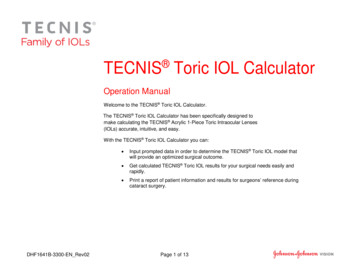

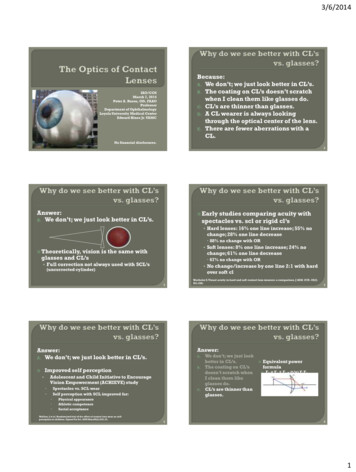
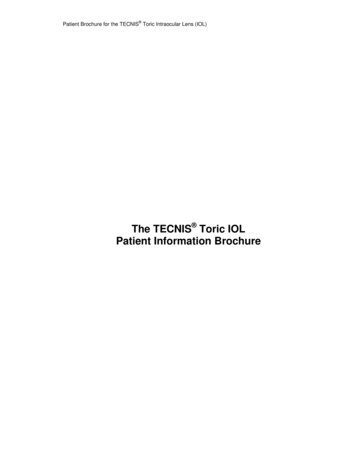
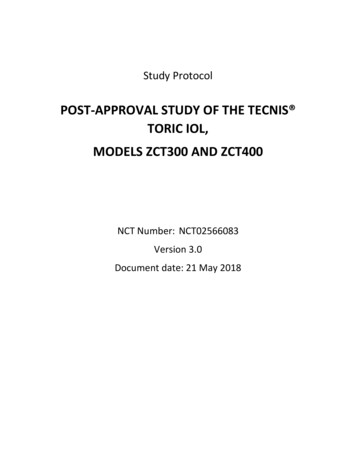


![No, David! (David Books [Shannon]) E Book](/img/65/no-20david-20david-20books-20shannon-20e-20book.jpg)


